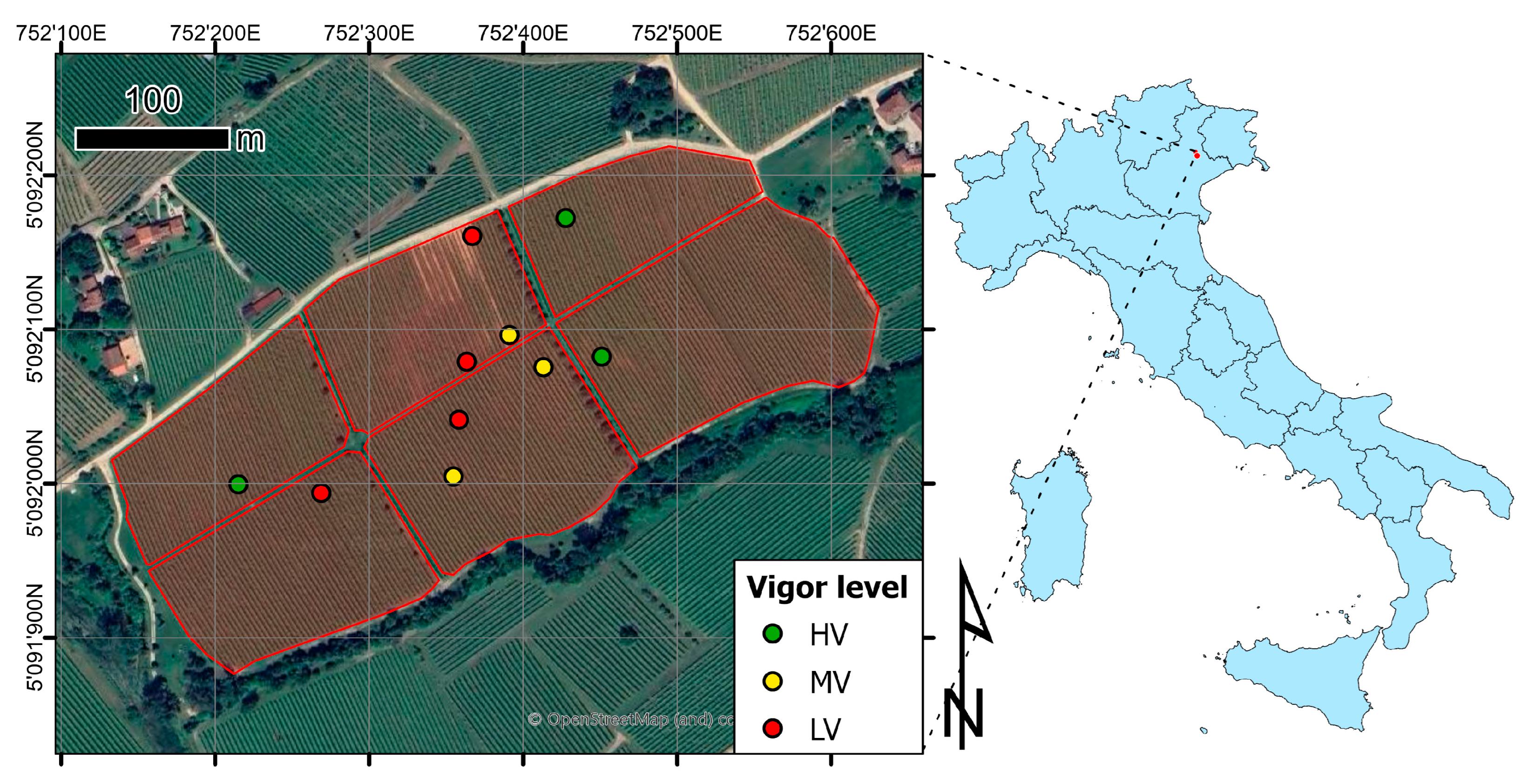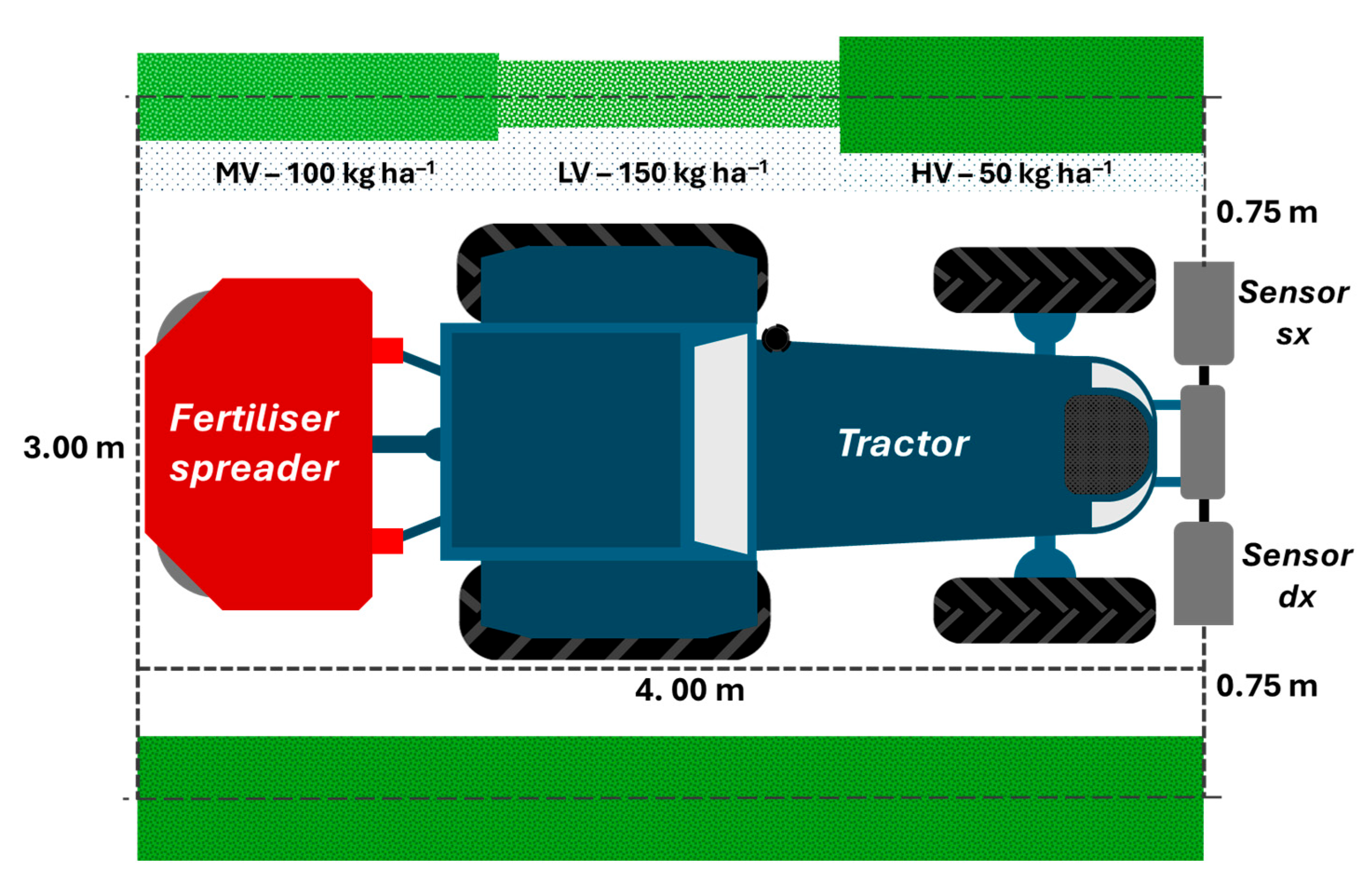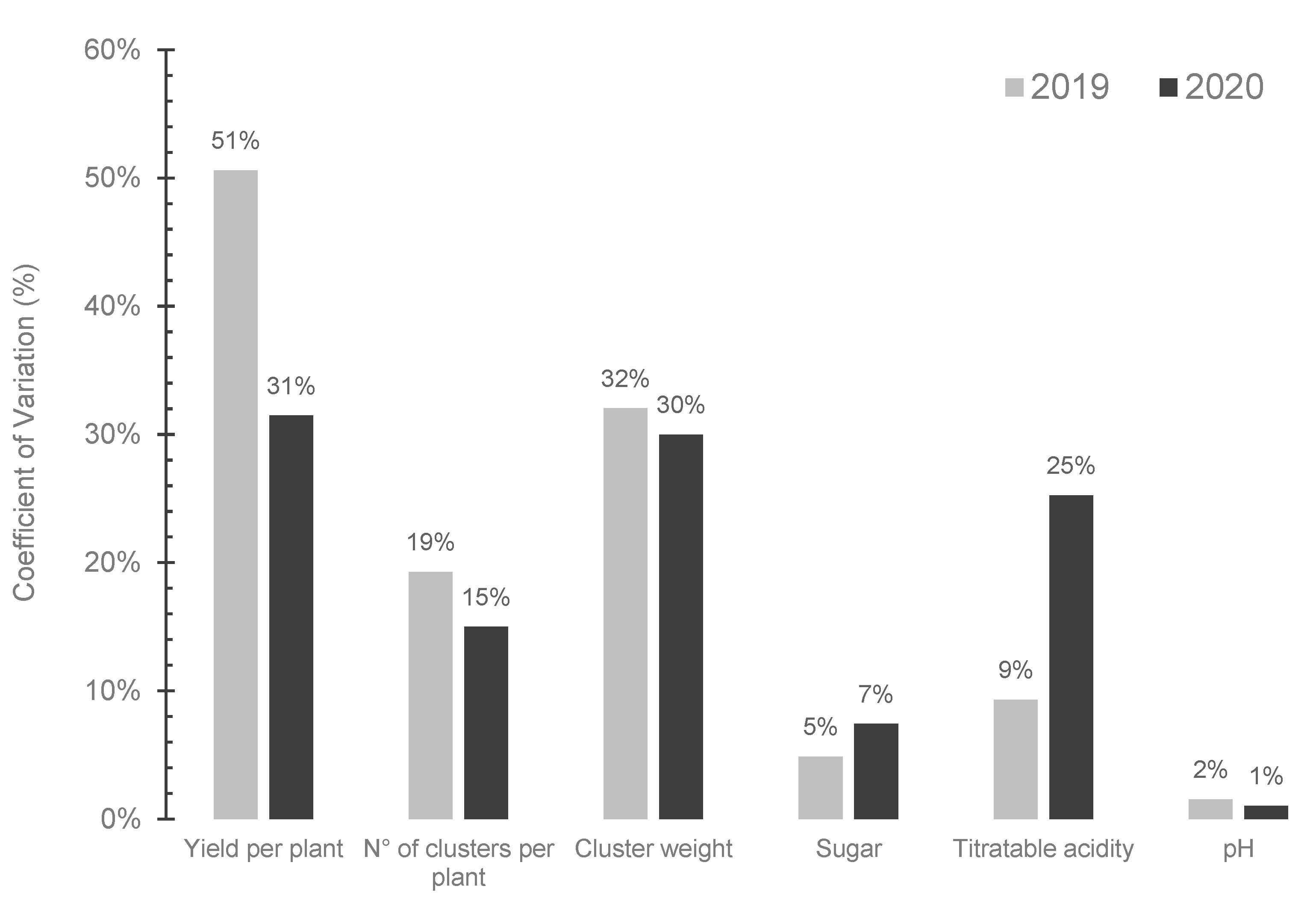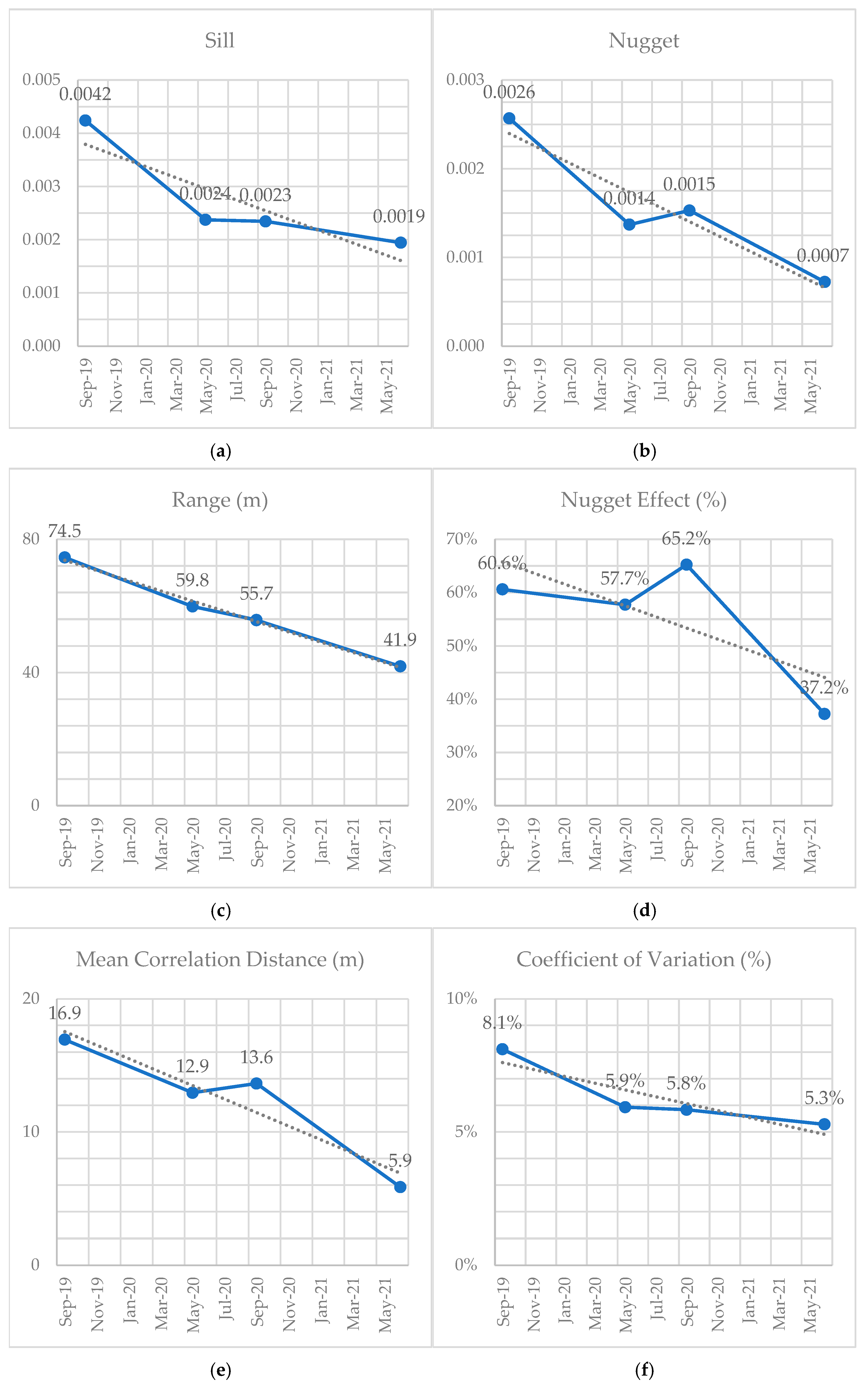Reducing Within-Vineyard Spatial Variability Through Real-Time Variable-Rate Fertilization: A Case Study in the Conegliano Valdobbiadene Prosecco DOCG Region
Abstract
1. Introduction
2. Materials and Methods
2.1. Study Area Description and Climatic Profiles of the Experimental Site
2.2. Fertiliser Management and Experimental Design
Real-Time (On-the-Go) Variable-Rate Fertiliser Application Procedure
2.3. Yield Components and Grape Composition
2.4. Statistical Analysis
3. Results
3.1. Yield Components and Grape Composition Results
3.2. Spatial Structure Analysis of NDVI
4. Discussion
Limitations and Future Research
5. Conclusions
Author Contributions
Funding
Institutional Review Board Statement
Informed Consent Statement
Data Availability Statement
Acknowledgments
Conflicts of Interest
References
- Yu, R.; Brillante, L.; Martínez-Lüscher, J.; Kurtural, S.K. Spatial Variability of Soil and Plant Water Status and Their Cascading Effects on Grapevine Physiology Are Linked to Berry and Wine Chemistry. Front. Plant Sci. 2020, 11, 790. [Google Scholar] [CrossRef]
- Tardaguila, J.; Stoll, M.; Gutiérrez, S.; Proffitt, T.; Diago, M.P. Smart Applications and Digital Technologies in Viticulture: A Review. Smart Agric. Technol. 2021, 1, 100005. [Google Scholar] [CrossRef]
- Sassu, A.; Gambella, F.; Ghiani, L.; Mercenaro, L.; Caria, M.; Pazzona, A.L. Advances in Unmanned Aerial System Remote Sensing for Precision Viticulture. Sensors 2021, 21, 956. [Google Scholar] [CrossRef]
- Liu, K.; Sozzi, M.; Gasparini, F.; Marinello, F.; Sartori, L. Combining Simulations and Field Experiments: Effects of Subsoiling Angle and Tillage Depth on Soil Structure and Energy Requirements. Comput. Electron. Agric. 2023, 214, 108323. [Google Scholar] [CrossRef]
- Mania, E.; Petrella, F.; Giovannozzi, M.; Piazzi, M.; Wilson, A.; Guidoni, S. Managing Vineyard Topography and Seasonal Variability to Improve Grape Quality and Vineyard Sustainability. Agronomy 2021, 11, 1142. [Google Scholar] [CrossRef]
- Van Leeuwen, C.; Seguin, G. The Concept of Terroir in Viticulture. J. Wine Res. 2006, 17, 1–10. [Google Scholar] [CrossRef]
- Uzkuç, N.M.Ç.; Uzkuç, H.; Kavdır, Y.; Hamzaoğlu, F.; Toklucu, A.K. Soil-Driven Terroir: Impacts on Vitis vinifera L. “Karasakiz” Wine Quality and Phenolic Composition. J. Food Compos. Anal. 2025, 142, 107444. [Google Scholar] [CrossRef]
- Liu, K.; Benetti, M.; Sozzi, M.; Gasparini, F.; Sartori, L. Soil Compaction under Different Traction Resistance Conditions—A Case Study in North Italy. Agriculture 2022, 12, 1954. [Google Scholar] [CrossRef]
- Gaiotti, F.; Tomasi, D. I Terroirs Del Conegliano Valdobbiadene Prosecco: Studio Sull’origine Della Qualità Nelle Colline Patrimonio Unesco; Antiga Edizioni: Crocetta del Montello, Italy, 2020; ISBN 9788884352057. [Google Scholar]
- Belfiore, N.; Amato, A.; Gardiman, M.; Gaiotti, F.; Zenoni, S.; Tornielli, G.B.; Fasoli, M.; Bavaresco, L. The Role of Terroir on the Ripening Traits of V. vinifera Cv ‘Glera’ in the Prosecco Area. Plants 2024, 13, 816. [Google Scholar] [CrossRef]
- Pepi, S.; Sansone, L.; Chicca, M.; Vaccaro, C. Relationship among Geochemical Elements in Soil and Grapes as Terroir Fingerprintings in Vitis vinifera L. Cv. “Glera”. Chemie Erde 2017, 77, 121–130. [Google Scholar] [CrossRef]
- Alessandrini, M.; Gaiotti, F.; Belfiore, N.; Matarese, F.; D’Onofrio, C.; Tomasi, D. Influence of Vineyard Altitude on Glera Grape Ripening (Vitis vinifera L.): Effects on Aroma Evolution and Wine Sensory Profile. J. Sci. Food Agric. 2017, 97, 2695–2705. [Google Scholar] [CrossRef] [PubMed]
- Vine, R.P.; Harkness, E.M.; Linton, S.J. Viticulture (Grape Growing). In Winemaking; Springer: Berlin/Heidelberg, Germany, 2002; pp. 24–70. [Google Scholar]
- Silvestroni, O.; Dottori, E.; Pallotti, L.; Lattanzi, T.; Santilocchi, R.; Lanari, V. Using Legume-Enriched Cover Crops to Improve Grape Yield and Quality in Hillside Vineyards. Agronomy 2024, 14, 2528. [Google Scholar] [CrossRef]
- Bois, B.; Pauthier, B.; Brillante, L.; Mathieu, O.; Leveque, J.; Van Leeuwen, C.; Castel, T.; Richard, Y. Sensitivity of Grapevine Soil–Water Balance to Rainfall Spatial Variability at Local Scale Level. Front. Environ. Sci. 2020, 8, 110. [Google Scholar] [CrossRef]
- Tugnolo, A.; Oliveira, H.M.; Giovenzana, V.; Fontes, N.; Silva, S.; Fernandes, C.; Graça, A.; Pampuri, A.; Casson, A.; Piteira, J.; et al. Quantitative Prediction of Grape Ripening Parameters Combining an Autonomous IoT Spectral Sensing System and Chemometrics. Comput. Electron. Agric. 2025, 230, 109856. [Google Scholar] [CrossRef]
- Ferro, M.V.; Catania, P. Technologies and Innovative Methods for Precision Viticulture: A Comprehensive Review. Horticulturae 2023, 9, 399. [Google Scholar] [CrossRef]
- Keller, M. The Science of Grapevines: Anatomy and Physiology, 2nd ed.; Elsevier Inc.: Amsterdam, The Netherlands, 2015; ISBN 9780124199873. [Google Scholar]
- Recchia, L.; Boncinelli, P.; Cini, E.; Vieri, M.; Pegna, F.G.; Sarri, D. Multicriteria Analysis and LCA Techniques: With Applications to Agro-Engineering Problems; Green Energy and Technology; Springer: Berlin/Heidelberg, Germany, 2011; Volume 91. [Google Scholar] [CrossRef]
- Recchia, L.; Sarri, D.; Rimediotti, M.; Boncinelli, P.; Cini, E.; Vieri, M. Towards the Environmental Sustainability Assessment for the Viticulture. J. Agric. Eng. 2018, 49, 19–28. [Google Scholar] [CrossRef]
- Kazimierczuk, K.; Barrows, S.E.; Olarte, M.V.; Qafoku, N.P. Decarbonization of Agriculture: The Greenhouse Gas Impacts and Economics of Existing and Emerging Climate-Smart Practices. ACS Eng. Au 2023, 3, 426–442. [Google Scholar] [CrossRef]
- Taylor, J.A.; Sanchez, L.; Sams, B.; Haggerty, L.; Jakubowski, R.; Djafour, S.; Bates, T.R. Evaluation of a Commercial Grape Yield Monitor for Use Mid-Season and at-Harvest. J. Int. Sci. Vigne du Vin 2016, 50, 57–63. [Google Scholar] [CrossRef]
- Sozzi, M.; Bernardi, E.; Kayad, A.; Marinello, F.; Boscaro, D.; Cogato, A.; Gasparini, F.; Tomasi, D. On-The-Go Variable Rate Fertilizer Application on Vineyard Using a Proximal Spectral Sensor. In Proceedings of the 2020 IEEE International Workshop on Metrology for Agriculture and Forestry (MetroAgriFor), Trento, Italy, 4–6 November 2020; pp. 343–347. [Google Scholar]
- Ammoniaci, M.; Kartsiotis, S.P.; Perria, R.; Storchi, P. State of the Art of Monitoring Technologies and Data Processing for Precision Viticulture. Agriculture 2021, 11, 201. [Google Scholar] [CrossRef]
- Hunter, J.J.; Bonnardot, V. Suitability of Some Climatic Parameters for Grapevine Cultivation in South Africa, with Focus on Key Physiological Processes. S. Afr. J. Enol. Vitic. 2011, 32, 137–154. [Google Scholar] [CrossRef]
- Huglin, M.P. Nouveau Mode d’évaluation Des Possibilités Héliothermiques d’un Milieu Viticole. Comptes Rendus L’académie D’agriculture Fr. 1978, 64, 1117–1126. [Google Scholar]
- Taylor, J.A.; Bates, T.R. Comparison of Different Vegetative Indices for Calibrating Proximal Canopy Sensors to Grapevine Pruning Weight. Am. J. Enol. Vitic. 2021, 72, 279–283. [Google Scholar] [CrossRef]
- Dorin, B.; Reynolds, A.G.; Lee, H.S.; Carrey, M.; Shemrock, A.; Shabanian, M. Detecting Cool-Climate Riesling Vineyard Variation Using Unmanned Aerial Vehicles and Proximal Sensors. Drone Syst. Appl. 2024, 12, 1–18. [Google Scholar] [CrossRef]
- Kasimati, A.; Psiroukis, V.; Darra, N.; Kalogrias, A.; Kalivas, D.; Taylor, J.A.; Fountas, S. Investigation of the Similarities between NDVI Maps from Different Proximal and Remote Sensing Platforms in Explaining Vineyard Variability. Precis. Agric. 2023, 24, 1220–1240. [Google Scholar] [CrossRef]
- Uribeetxebarria, A.; Martínez-Casasnovas, J.A.; Escolà, A.; Rosell-Polo, J.R.; Arnó, J. Stratified Sampling in Fruit Orchards Using Cluster-Based Ancillary Information Maps: A Comparative Analysis to Improve Yield and Quality Estimates. Precis. Agric. 2019, 20, 179–192. [Google Scholar] [CrossRef]
- Lloyd, S.P. Least Squares Quantization in PCM. IEEE Trans. Inf. Theory 1982, 28, 129–137. [Google Scholar] [CrossRef]
- Leroux, C.; Tisseyre, B. How to Measure and Report Within-Field Variability: A Review of Common Indicators and Their Sensitivity. Precis. Agric. 2019, 20, 562–590. [Google Scholar] [CrossRef]
- Cambardella, C.A.; Moorman, T.B.; Novak, J.M.; Parkin, T.B.; Karlen, D.L.; Turco, R.F.; Konopka, A.E. Field-Scale Variability of Soil Properties in Central Iowa Soils. Soil Sci. Soc. Am. J. 1994, 58, 1501–1511. [Google Scholar] [CrossRef]
- Han, S.; Hummel, J.W.; Goering, C.E.; Cahn, M.D. Cell Size Selection for Site-Specific Crop Management. Trans. ASAE 1994, 37, 19–26. [Google Scholar] [CrossRef]
- Cambardella, C.A.; Karlen, D.L. Spatial Analysis of Soil Fertility Parameters. Precis. Agric. 1999, 1, 5–14. [Google Scholar] [CrossRef]
- Gatti, M.; Squeri, C.; Garavani, A.; Frioni, T.; Dosso, P.; Diti, I.; Poni, S. Effects of Variable Rate Nitrogen Application on Cv. Barbera Performance: Yield and Grape Composition. Am. J. Enol. Vitic. 2019, 70, 188–200. [Google Scholar] [CrossRef]
- Silc Informa. Quotazioni Nazionali. 2021. Available online: https://www.silcfertilizzanti.it/wp-content/uploads/2021/04/sett5.pdf (accessed on 24 August 2025).
- Wernet, G.; Bauer, C.; Steubing, B.; Reinhard, J.; Moreno-Ruiz, E.; Weidema, B. The Ecoinvent Database Version 3 (Part I): Overview and Methodology. Int. J. Life Cycle Assess. 2016, 21, 1218–1230. [Google Scholar] [CrossRef]
- Balafoutis, A.T.; Koundouras, S.; Anastasiou, E.; Fountas, S.; Arvanitis, K. Life Cycle Assessment of Two Vineyards after the Application of Precision Viticulture Techniques: A Case Study. Sustainability 2017, 9, 1997. [Google Scholar] [CrossRef]
- Zhao, M.; Guerrero, A.; Muhammad, M.A.; Lauwers, L.; Mouazen, A.M. Within-Field Spatial Variability and Potential for Profitability of Variable Rate Applications. Precis. Agric. 2023, 24, 2248–2263. [Google Scholar] [CrossRef]
- Gatti, M.; Garavani, A.; Squeri, C.; Diti, I.; De Monte, A.; Scotti, C.; Poni, S. Effects of Intra-Vineyard Variability and Soil Heterogeneity on Vine Performance, Dry Matter and Nutrient Partitioning. Precis. Agric. 2022, 23, 150–177. [Google Scholar] [CrossRef]
- Bramley, R.G.V.; Trought, M.C.T.; Praat, J.P. Vineyard Variability in Marlborough, New Zealand: Characterising Variation in Vineyard Performance and Options for the Implementation of Precision Viticulture. Aust. J. Grape Wine Res. 2011, 17, 83–89. [Google Scholar] [CrossRef]
- Bramley, R.G.V.; Ouzman, J.; Trought, M.C.T.; Neal, S.M.; Bennett, J.S. Spatio-Temporal Variability in Vine Vigour and Yield in a Marlborough Sauvignon Blanc Vineyard. Aust. J. Grape Wine Res. 2019, 25, 430–438. [Google Scholar] [CrossRef]
- Verdugo-Vásquez, N.; Villalobos-Soublett, E.; Gutiérrez-Gamboa, G.; Araya-Alman, M. Spatial Variability of Production and Quality in Table Grapes ‘Flame Seedless’ Growing on a Flat Terrain and Slope Site. Horticulturae 2021, 7, 254. [Google Scholar] [CrossRef]







| Year | Average Temperature (April– September) °C | Rainfall (April– September) mm | Average Temperature (August– September) °C | Rainfall (August– September) mm | Average Temperature Range (August–September) °C |
|---|---|---|---|---|---|
| Average 1980–2018 | 19.9 | 673.6 | 21.4 | 348.5 | 10.9 |
| Average 2019–2020 | 20.6 | 797.3 | 22.6 | 168.1 | 9.5 |
| 2019 | 20.7 | 827.2 | 22.6 | 178.0 | 9.2 |
| 2020 | 20.6 | 767.4 | 22.7 | 158.2 | 9.8 |
| Action | Strategy | Rate | Fertiliser | Stages | |
|---|---|---|---|---|---|
| 2009–2019 | NDVI survey | BBCH89 | |||
| 2001–2020 | Fertiliser application | Low–Medium NDVI areas | 30 t ha−1 | manure | BBCH00 |
| 2005–2020 | Fertiliser application | Real-time VRA based on NDVI | 50–100–150 kg ha−1 | NPK 15-5-20 | BBCH55 |
| 2009–2020 | NDVI survey | BBCH89 | |||
| 2010–2020 | Fertiliser application | Prescription map VRA based on previous NDVI | 50–100–150 kg ha−1 | NPK 15-5-20 | BBCH91 |
| 2006–2021 | Fertiliser application | Real-time VRA based on NDVI | 50–100–150 kg ha−1 | NPK 15-5-20 | BBCH57 |
| (a) | ||||
| Yield Per Plant (kg) | N° of Clusters Per Plant | Cluster Weight (g) | Pre-Harvest NDVI | |
| 2019 | ||||
| Low vigour | 2.64 ± 0.55 a | 26.96 ± 2.74 bd | 98.79 ± 21.69 b | 0.76 ± 0.04 c |
| Medium vigour | 4.52 ± 0.55 ab | 30.93 ± 3.33 ab | 147.34 ± 19.19 ab | 0.79 ± 0.05 abc |
| High vigour | 7.56 ± 1.79 c | 39.19 ± 6.22 a | 192.45 ± 22.46 ab | 0.85 ± 0.02 ab |
| Average | 4.91 ± 0.85 | 32.36 ± 4.09 | 146.19 ± 21.11 | 0.80 ± 0.04 |
| 2020 | ||||
| Low vigour | 3.17 ± 0.99 a | 14.19 ± 3.50 c | 224.99 ± 58.96 ac | 0.78 ± 0.03 bc |
| Medium vigour | 5.87 ± 1.00 bc | 18.14 ± 5.05 cd | 331.47 ± 51.51 cd | 0.82 ± 0.01 abc |
| High vigour | 5.90 ± 1.07 bc | 14.06 ± 0.08 c | 419.98 ± 78.92 d | 0.86 ± 0.00 a |
| Average | 4.98 ± 1.02 | 15.46 ± 2.87 | 325.48 ± 63.13 | 0.82 ± 0.01 |
| (b) | ||||
| TSS (°Bx) | Titratable Acidity (g × L−1) | pH | Pre-Harvest NDVI | |
| 2019 | ||||
| Low vigour | 19.11 ± 0.54 a | 5.03 ± 0.51 a | 3.40 ± 0.05 b | 0.76 ± 0.04 c |
| Medium vigour | 18.33 ± 0.58 ab | 5.52 ± 0.34 ab | 3.33 ± 0.05 ab | 0.79 ± 0.05 abc |
| High vigour | 17.33 ± 0.90 ab | 6.06 ± 0.25 ab | 3.30 ± 0 ab | 0.85 ± 0.02 ab |
| Average | 18.24 ± 0.68 | 5.53 ± 0.36 | 3.34 ± 0.03 | 0.80 ± 0.04 |
| 2020 | ||||
| Low vigour | 19.00 ± 0.67 a | 5.07 ± 0.38 a | 3.28 ± 0.07 a | 0.78 ± 0.03 bc |
| Medium vigour | 18.73 ± 0.61 a | 4.62 ± 0.47 a | 3.34 ± 0.02 ab | 0.82 ± 0.01 abc |
| High vigour | 16.55 ± 1.20 b | 7.29 ± 1.54 b | 3.28 ± 0.04 a | 0.86 ± 0.00 a |
| Average | 18.09 ± 0.83 | 5.66 ± 0.80 | 3.30 ± 0.05 | 0.82 ± 0.01 |
Disclaimer/Publisher’s Note: The statements, opinions and data contained in all publications are solely those of the individual author(s) and contributor(s) and not of MDPI and/or the editor(s). MDPI and/or the editor(s) disclaim responsibility for any injury to people or property resulting from any ideas, methods, instructions or products referred to in the content. |
© 2025 by the authors. Licensee MDPI, Basel, Switzerland. This article is an open access article distributed under the terms and conditions of the Creative Commons Attribution (CC BY) license (https://creativecommons.org/licenses/by/4.0/).
Share and Cite
Sozzi, M.; Boscaro, D.; Zanchin, A.; Marinello, F.; Tomasi, D. Reducing Within-Vineyard Spatial Variability Through Real-Time Variable-Rate Fertilization: A Case Study in the Conegliano Valdobbiadene Prosecco DOCG Region. AgriEngineering 2025, 7, 280. https://doi.org/10.3390/agriengineering7090280
Sozzi M, Boscaro D, Zanchin A, Marinello F, Tomasi D. Reducing Within-Vineyard Spatial Variability Through Real-Time Variable-Rate Fertilization: A Case Study in the Conegliano Valdobbiadene Prosecco DOCG Region. AgriEngineering. 2025; 7(9):280. https://doi.org/10.3390/agriengineering7090280
Chicago/Turabian StyleSozzi, Marco, Davide Boscaro, Alessandro Zanchin, Francesco Marinello, and Diego Tomasi. 2025. "Reducing Within-Vineyard Spatial Variability Through Real-Time Variable-Rate Fertilization: A Case Study in the Conegliano Valdobbiadene Prosecco DOCG Region" AgriEngineering 7, no. 9: 280. https://doi.org/10.3390/agriengineering7090280
APA StyleSozzi, M., Boscaro, D., Zanchin, A., Marinello, F., & Tomasi, D. (2025). Reducing Within-Vineyard Spatial Variability Through Real-Time Variable-Rate Fertilization: A Case Study in the Conegliano Valdobbiadene Prosecco DOCG Region. AgriEngineering, 7(9), 280. https://doi.org/10.3390/agriengineering7090280












